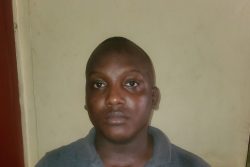The Guyana Geology and Mines Commission (GGMC) yesterday confirmed that use of mercury-free technology remains only in the testing phase here and denied that nothing is being done.
“The Commission has continuously and unwaveringly worked to identify and test appropriate technologies that can best be adopted given the unique mining sector of Guyana,” Secretary of the GGMC Board of Directors Jacques Foster said in a letter sent to media organisations.
He said that the Chairman and Board of Directors of the GGMC had noted with interest the statements by President of the Guyana Gold and Diamond Miners Association (GGDMA) Patrick Harding in the Sunday Stabroek in an article headlined ‘Gold Miners still to tap billion-dollar fund to go mercury-free.’
The article reported that miners have not yet accessed the $1 billion revolving fund set up to examine and test mercury-free gold mining equipment, with Harding saying that many of the technologies are very expensive. Last April, Chairman of the GGMC Board of Directors Clinton Williams had said that the $1 billion fund to examine and test mercury-free gold mining equipment would be activated “soon.”
He had said the $1 billion was intended to support the technological development, fabrication and testing of prototype plants and equipment and to seek to increase recovery rates of gold and reducing mercury use in the gold recovery process. When contacted last week for an update on the fund, Williams had promised to send a response by Friday but did not do so.
In the letter yesterday, Foster said the Ministry of Natural Resources and the Environment had taken the proactive step of establishing a Mercury Free Mining Development Fund (MFMDF) given the commitment to the Minamata Convention which was supported by the GGDMA.
He said that in operationalizing the MFMDF, commercial banks and financial institutions were invited to submit proposals for the management of the $1 billion financing facility. “However, emanating from a meeting with the representatives of the financial institutions, was a request for the technical criteria that would be used in the evaluation of applications for funding,” Foster said.
“Given this, note was taken of the critical need for the identification of the relevant alternative technologies and testing to ensure that these technologies are appropriate and is best suited for the various areas. This was deemed a first step before the funds allocated to the Mercury Free Mining Development Fund can be dispersed to assist in the adoption of the relevant technologies,” the GGMC Board secretary said.
He added that a Working Group comprising the Institute of Applied Sciences and Technology (IAST), University of Guyana (UG), Guyana Mining School and Training Centre (GMSTCI) and the GGMC and GGMDA was established to undertake the identification and testing of alternative technologies and to make the necessary recommendations to the Board to guide the technical criteria required by the financial institutions.
According to Foster, the Working Group to date has tested various technologies such as Gold Flotation, Knelson Concentrators, Shaking Tables, Gold Katcha and will be field testing the Spiral Concentrator. “Extensive field testing of these and other alternative technologies are being and will be undertaken,” he asserted.
Foster said the position of Harding has wavered as regards the use of the allocated funds. In the third quarter of 2014, the Commission received a letter from Harding indicating that the position of GGDMA on the use of the funds was to evenly distribute the allocated funds to the small miners, he said.
“This approach was not deemed satisfactory to the Commission given that it would not serve to develop the sector but rather provide short-term financing for operations; which was not the objective of the facility. In this regard, the Commission sought to engage GGDMA on its position. However, in a letter in the fourth quarter of 2014 the Association withdrew its proposal for the distribution of the funds and reiterated its support to the ongoing efforts of the Commission to identify and test appropriate technologies and processes with the aim of eliminating the use of mercury and increasing gold recovery rates,” Foster wrote.
He said that in December, the Commission and GGDMA reengaged in discussions which resulted in the identification of specific mining properties that key equipment can be field tested on. “More so, a protocol for the use and testing of the equipment by miners is currently being developed jointly by the Commission and the Association,” Foster said.
He stated that in this regard, “the impression created in the article that nothing is being done is erroneous and misleading to the citizenry and stakeholders of the sector.”
According to Foster, the Ministry and the Commission have worked tirelessly in promoting alternative recovery processes with the aim of developing the sector and promoting efficient mining practices.
“The Association is in agreement that the identification and testing of the various mercury free and improved recovery processes is critical and necessary to avoid the wastage of scarce financial resources.
Notwithstanding this, the importance of these alternative processes is well noted given the Minamata Convention and the current low recovery rate in the sector,” Foster added.







